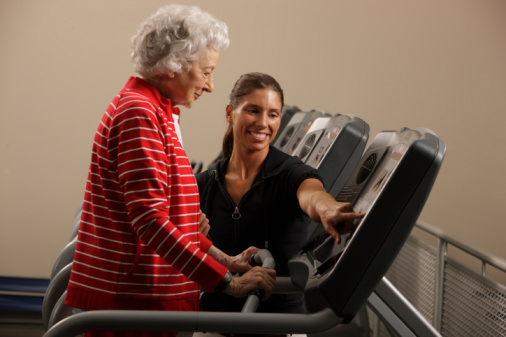
08 Jul What is Pulmonary Rehabilitation?
Pulmonary Rehab is a program of exercise, education and training for patients with chronic and advanced lung diseases, such as chronic obstructive pulmonary disease (COPD) and idiopathic pulmonary fibrosis (IPF). It is designed to help patients improve their functional status and quality of life. It is done, usually, at either a free-standing pulmonary rehab facility or at a hospital or clinic multi-use rehab facility. A multi-disciplinary team of professionals guide patients through the usually 8 – 12 week long program, consisting of 2 – 3, one to two hour sessions, per week.
Pulmonary rehab, as a distinct program for patients with advanced lung disease, was first conceived and developed by Dr. Thomas Petty, a giant in the world of pulmonary diseases, at The University of Colorado in the 1960s. The program spread, and by the 1990s enough scientific evidence of its effectiveness had accumulated that all the major societies for the treatment of lung diseases, including The American Thoracic Society, and the American College of Chest Physicians, strongly endorsed the program. Around the year 2000 Medicare approved it as therapy for a number of advanced lung diseases, as well.
Pulmonary rehab is designed to improve several physical problems that arise as a result of advanced lung disease. Rehab program exercises specifically improve peripheral muscle weakness, and respiratory muscle weakness. Advance lung disease, itself, causes muscle protein breakdown. Additionally, the lack of muscle exercise, because lung function can’t support exercise (I’m too short of breathe to exercise), causes muscle loss. A major focus of rehab is cardio-pulmonary conditioning. That is, “aerobic” exercises that improve endurance. Such exercises include walking, stationary cycling, etc. These exercises are often done while using oxygen. Therapist will train patients on when and how much oxygen to use when exercising.
Pulmonary rehab also trains patients in optimal breathing techniques such as “pursed lip breathing”. Occupational therapists teach patients about “energy conservation techniques”, and even physical equipment that can be used by the lung patient to extend and improve day to day function.
Nutritionists sometimes counsel patients about strategies to combat the weight loss and nutritional deficiencies that occur in some chronic lung diseases. Alternatively, nutritionists can counsel patients about excess weight that contributes to functional limitation.
Social workers are sometimes involved to help patients optimize their lifestyles, and living situations, toward a situation that best fits their lung disease.
One of the unexpected benefits of rehab is that patients discover that they are not alone in their struggles. At rehab patients meet others with similar challenges. These other patients and the overall positive and supportive environment of a rehab centre can be very educational and encouraging to a patient with lung disease.
Source:
http://www.houstonlungdocs.com

